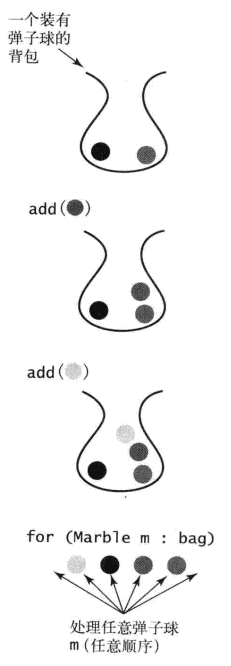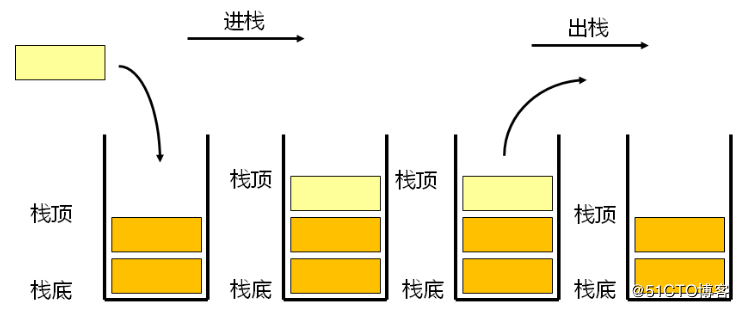一.背包
背包是一种不支持从中删除元素的集合数据类型,目的是帮助用例收集元素并迭代所有收集到的元素,也可以检查背包是否为空,或者获取背包中元素的数量。背包里面的元素的顺序不确定。
要理解背包的概念,可以想象一个喜欢收集弹珠球的人。他将所有的弹珠球都放在一个背包里,一次一个,并且会不时在所有的弹珠球中寻找某一颗;

1.用链表实现
import edu.princeton.cs.algs4.StdIn;
import edu.princeton.cs.algs4.StdOut;
import java.util.Iterator;
import java.util.NoSuchElementException;
public class Bag<Item> implements Iterable<Item> {
private Node<Item> first;
private int n;
private static class Node<Item> {
private Item item;
private Node<Item> next;
}
/**
* Initializes an empty bag.
*/
public Bag() {
first = null;
n = 0;
}
public boolean isEmpty() {
return first == null;
}
public int size() {
return n;
}
public void add(Item item) {
Node<Item> oldfirst = first;
first = new Node<Item>();
first.item = item;
first.next = oldfirst;
n++;
}
public Iterator<Item> iterator() {
return new ListIterator(first);
}
private class ListIterator implements Iterator<Item> {
private Node<Item> current;
public ListIterator(Node<Item> first) {
current = first;
}
public boolean hasNext() { return current != null; }
public void remove() { throw new UnsupportedOperationException(); }
public Item next() {
if (!hasNext()) throw new NoSuchElementException();
Item item = current.item;
current = current.next;
return item;
}
}
public static void main(String[] args) {
Bag<String> bag = new Bag<String>();
while (!StdIn.isEmpty()) {
String item = StdIn.readString();
bag.add(item);
}
StdOut.println("size of bag = " + bag.size());
for (String s : bag) {
StdOut.println(s);
}
}
}
二.队列
队列的特性:
-
在队尾插入元素,在队首删除元素。
-
FIFO(先进先出),就向排队取票一样。
1.用链表实现
package structure;
import edu.princeton.cs.algs4.StdIn;
import edu.princeton.cs.algs4.StdOut;
import java.util.Iterator;
import java.util.NoSuchElementException;
public class Queue<Item> implements Iterable<Item> {
private Node<Item> first;
private Node<Item> last;
private int n;
private static class Node<Item> {
private Item item;
private Node<Item> next;
}
public Queue() {
first = null;
last = null;
n = 0;
}
public boolean isEmpty() {
return first == null;
}
public int size() {
return n;
}
public Item peek() {
if (isEmpty()) throw new NoSuchElementException("Queue underflow");
return first.item;
}
//增加元素
public void enqueue(Item item) {
Node<Item> oldlast = last;
last = new Node<Item>();
last.item = item;
last.next = null;
if (isEmpty()) first = last;
else oldlast.next = last;
n++;
}
//删除元素
public Item dequeue() {
if (isEmpty()) throw new NoSuchElementException("Queue underflow");
Item item = first.item;
first = first.next;
n--;
if (isEmpty()) last = null; // to avoid loitering
return item;
}
public String toString() {
StringBuilder s = new StringBuilder();
for (Item item : this) {
s.append(item);
s.append(' ');
}
return s.toString();
}
public Iterator<Item> iterator() {
return new ListIterator(first);
}
private class ListIterator implements Iterator<Item> {
private Node<Item> current;
public ListIterator(Node<Item> first) {
current = first;
}
public boolean hasNext() { return current != null; }
public void remove() { throw new UnsupportedOperationException(); }
public Item next() {
if (!hasNext()) throw new NoSuchElementException();
Item item = current.item;
current = current.next;
return item;
}
}
public static void main(String[] args) {
Queue<String> queue = new Queue<String>();
while (!StdIn.isEmpty()) {
String item = StdIn.readString();
if (!item.equals("-"))
queue.enqueue(item);
else if (!queue.isEmpty())
StdOut.print(queue.dequeue() + " ");
}
StdOut.println("(" + queue.size() + " left on queue)");
}
}
三.栈
(1)栈是一种线性结构,栈中的元素遵循先入后出的原则,最先进入的元素所在位置叫做栈底,最后放入的元素所在位置叫做栈顶。
这种结构类似于盛放羽毛球的圆筒,一端封闭,另一端开口,先放入的羽毛球位于筒的底部(即栈底),后放入的羽毛球位于筒的入口(即栈顶)。
(2)栈也是一种抽象的逻辑结构,依赖于物理结构(如数组、链表)而存在。既可以使用数组实现,也可以使用链表实现。
(3)出栈、入栈的时间复杂都是O(1)。

1.用数组实现
import edu.princeton.cs.algs4.StdIn;import edu.princeton.cs.algs4.StdOut;import java.util.Iterator;import java.util.NoSuchElementException;public class ResizingArrayStack<Item> implements Iterable<Item> { private Item[] a; private int n; public ResizingArrayStack() { a = (Item[]) new Object[2]; n = 0; } public boolean isEmpty() { return n == 0; } public int size() { return n; } //重置数组大小 private void resize(int capacity) { assert capacity >= n; // textbook implementation Item[] temp = (Item[]) new Object[capacity]; for (int i = 0; i < n; i++) { temp[i] = a[i]; } a = temp; // alternative implementation // a = java.util.Arrays.copyOf(a, capacity); } public void push(Item item) { if (n == a.length) resize(2*a.length); a[n++] = item; } public Item pop() { if (isEmpty()) throw new NoSuchElementException("Stack underflow"); Item item = a[n-1]; a[n-1] = null; n--; if (n > 0 && n == a.length/4) resize(a.length/2); return item; } // 返回栈顶部数据,但不移除 public Item peek() { if (isEmpty()) throw new NoSuchElementException("Stack underflow"); return a[n-1]; } public Iterator<Item> iterator() { return new ReverseArrayIterator(); } private class ReverseArrayIterator implements Iterator<Item> { private int i; public ReverseArrayIterator() { i = n-1; } public boolean hasNext() { return i >= 0; } public void remove() { throw new UnsupportedOperationException(); } public Item next() { if (!hasNext()) throw new NoSuchElementException(); return a[i--]; } } public static void main(String[] args) { ResizingArrayStack<String> stack = new ResizingArrayStack<String>(); while (!StdIn.isEmpty()) { String item = StdIn.readString(); if (!item.equals("-")) stack.push(item); else if (!stack.isEmpty()) StdOut.print(stack.pop() + " "); } StdOut.println("(" + stack.size() + " left on stack)"); }}
2.用链表实现
import edu.princeton.cs.algs4.StdIn;
import edu.princeton.cs.algs4.StdOut;
import java.util.Iterator;
import java.util.NoSuchElementException;
public class Stack<Item> implements Iterable<Item> {
private Node<Item> first;
private int n;
private static class Node<Item> {
private Item item;
private Node<Item> next;
}
public Stack() {
first = null;
n = 0;
}
public boolean isEmpty() {
return first == null;
}
public int size() {
return n;
}
public void push(Item item) {
Node<Item> oldfirst = first;
first = new Node<Item>();
first.item = item;
first.next = oldfirst;
n++;
}
public Item pop() {
if (isEmpty()) throw new NoSuchElementException("Stack underflow");
Item item = first.item; // save item to return
first = first.next; // delete first node
n--;
return item; // return the saved item
}
//返回栈顶部数据,但不移除
public Item peek() {
if (isEmpty()) throw new NoSuchElementException("Stack underflow");
return first.item;
}
public String toString() {
StringBuilder s = new StringBuilder();
for (Item item : this) {
s.append(item);
s.append(' ');
}
return s.toString();
}
public Iterator<Item> iterator() {
return new ListIterator(first);
}
private class ListIterator implements Iterator<Item> {
private Node<Item> current;
public ListIterator(Node<Item> first) {
current = first;
}
public boolean hasNext() {
return current != null;
}
public void remove() {
throw new UnsupportedOperationException();
}
public Item next() {
if (!hasNext()) throw new NoSuchElementException();
Item item = current.item;
current = current.next;
return item;
}
}
public static void main(String[] args) {
Stack<String> stack = new Stack<String>();
while (!StdIn.isEmpty()) {
String item = StdIn.readString();
if (!item.equals("-"))
stack.push(item);
else if (!stack.isEmpty())
StdOut.print(stack.pop() + " ");
}
StdOut.println("(" + stack.size() + " left on stack)");
}
}
来源:https://www.cnblogs.com/wuwuyong/p/12266647.html
